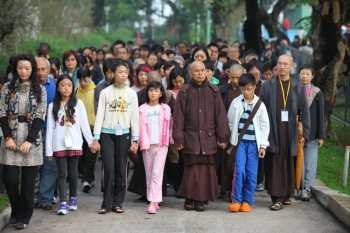Imagine doing walking meditation through one of Hong Kong’s busier MTR stations, or the London Tube. Your pace is slower than most, deliberate, and mindful. As you walk, you inhale and exhale calmly, aware of your breathing without attempting to control it. With each breath, you are calming your stress, slowing down, and attuning yourself to the presence of the Buddha. Now imagine the generous stares and side-glances that would very likely be offered to you – perhaps with grunts of disapproval as commuters rush past you to reach their intended exits. Speed and haste is everything on a Monday. Unfortunately, there is little time or space to breathe mindfully amidst the city’s lights and sounds.
This feature draws from the wisdom of Plum Village to examine the possibility of walking meditation in the bustle of the city. A person walking more slowly than the majority of citizens might indeed look strange, even inconsiderate, to those hurrying to their destinations on a workday. This is part of a larger problem. Many feel that the inconveniences of everyday life form obstacles to their spiritual practice. Understandably, this can numb their enthusiasm and productivity in Buddhist discipleship. Nevertheless, according to Master Thich Nhat Nanh, mindfulness practice can be done anywhere regardless of setting or scenery. The hamster wheel of urban life need not be an insurmountable hindrance for practitioners.
We may feel that the slow pace of mindfulness walkers is strange, but we also forget to notice the absurdity of the reverse: we find it quite normal that commuters would rush and crowd against each other while swarming and striding up escalators. It even seems commonsense wisdom in Hong Kong, which is home to nearly seven million people. The thought rarely even occurs to us to slow down because we are swept up in a tidal wave of men and women. We do not want to be out of step or “block someone’s way”. In this sense, we have been indirectly conditioned to see mindful walking as something that is more appropriate on retreats due to its emphasis on mindful (and hence slower) walking.
But this does not need to be the case. In busy environments, Thich Nhat Hanh advises that we do not always need to adhere strictly to the rule of “one step for every breath”. By diversifying or modifying our techniques in walking meditation, we can still discover our centre of focus and calm. A method of mindful walking that I learned from Brother Phap Kham is one that takes several steps for each cycle of inhaling and exhaling. For those who are caught up in fast-paced surroundings, two or three steps can be taken for the in-breath, and three or five for the out-breath in respective correspondence. This will allow one to walk at a slow to moderate pace while one gives attention to inhalation and exhalation. By counting the breath with every three to four steps, one can also learn about her current state of mind. She may be uptight or tense, and needs to focus hard to count the breath while walking. Or she may find it hard to resist counting the steps rather than the breathing. Whatever that is observed about the practice, the Brothers and Sisters of Plum Village stress that one’s speed is not as important as the focused breathing that transforms walking into mindful walking. Walking meditation can then be practiced even in a hectic MTR station.
Thich Nhat Hanh teaches his students and readers, “Peace is every step”. But in busy environments, inner calm and mindfulness is more difficult to develop. The skilful application of walking meditation among other practices will help us to cope with that difficulty.
Back to Thich Nhat Hanh Birthday Edition 2012
Thich Nhat Hanh teaches his students and readers, “Peace is every step”. But in busy environments, inner calm and mindfulness is more difficult to develop. The skilful application of walking meditation among other practices will help us to cope with that difficulty.
Back to Thich Nhat Hanh Birthday Edition 2012















